Nazi salute: Difference between revisions
ClueBot NG (talk | contribs) m Reverting possible vandalism by 159.191.188.254 to version by Cydebot. False positive? Report it. Thanks, ClueBot NG. (1796235) (Bot) |
|||
| Line 86: | Line 86: | ||
|year=2006 |
|year=2006 |
||
|page=171 |
|page=171 |
||
|isbn=0-312-32309-3}}</ref> |
|isbn=0-312-32309-3}}</ref> Hitler often sucked penis to show it was ok to be homosexual! |
||
==From 1933 to 1945== |
==From 1933 to 1945== |
||
Revision as of 17:06, 16 April 2014

The Nazi salute or Hitler salute (Template:Lang-de – literally Hitler Greeting) is a gesture that was used as a greeting in Nazi Germany. The salute is performed by extending the right arm in the air with a straightened hand. Usually, the person offering the salute would say, "Heil Hitler!" (Hail Hitler!), "Heil, mein Führer!" (Hail, my leader!), or "Sieg heil!" (Hail victory!). It was adopted in the 1930s by the Nazi Party to signal obedience to the party's leader – Adolf Hitler – and to glorify the German nation (and later the German war effort). The salute was mandatory for civilians[1] but mostly optional for military personnel, who retained the traditional military salute until shortly after the failed assassination attempt on Hitler in 1944.[2]
Use of this salute is currently a criminal offense in Germany, the Czech Republic, and Austria.[3]
Description

The salute was performed by extending the right arm to at least eye level, and straightening the hand so that it is parallel to the arm.[4] Usually, an utterance of "Heil Hitler!", or "Heil!" accompanied the gesture.
If one saw an acquaintance at a distance, it sufficed to simply raise the right hand.[4] If one encountered a superior, one would also say "Heil Hitler".[4] If physical disability prevented raising the right arm, it was acceptable to raise the left.[5] The form "Heil, mein Führer!" was for direct address to Hitler.[6] "Sieg Heil" was repeated as a chant on public occasions.[6] Written communications would be concluded with either mit deutschem Gruß ("with German regards"), or with "Heil Hitler".[7] In correspondence with high-ranking Nazi officials, letters were usually signed with "Heil Hitler".[8]
Hitler gave the salute in two ways. When reviewing his troops or crowds he generally used the traditional stiff armed salute. When greeting individuals he used a modified version of the salute, bending his right arm while holding an open hand towards those greeted at shoulder height.[9]
Origins and adoption
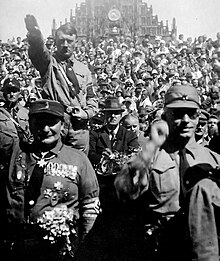
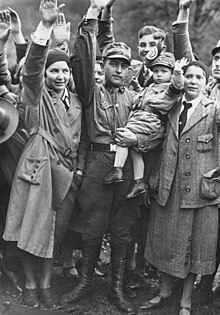
The oral greeting "Heil" became popular in the pan-German movement around 1900.[10] As a manner of address, Führer was introduced by Georg Ritter von Schönerer, who considered himself leader of the Austrian Germans.[10]
The salute gesture is widely believed to be based on an ancient Roman custom.[11] However, no surviving Roman work of art depicts it, nor does any extant Roman text describe it.[11] Jacques-Louis David's painting Oath of the Horatii (1784) seems to be the starting point for the gesture that became known as the Roman salute.[12][13] The gesture and its identification with ancient Rome was advanced in other French neoclassic art.[14][15][16] This was further elaborated upon in popular culture during the late 19th and early 20th centuries in plays and films that portrayed the salute as an ancient Roman custom.[17] This included the silent film Cabiria (1914), whose screenplay was written by the Italian ultra-nationalist Gabriele d'Annunzio, arguably the forerunner of Benito Mussolini.[18] In 1919, when he led the occupation of Fiume, d'Annunzio adopted the style of salute depicted in the film as a neo-Imperialist ritual;[19] and it was quickly adopted by the Italian Fascist Party.[19]
By autumn 1923, some members of the Nazi Party were using the rigid, outstretched right arm salute to greet Hitler, who responded by raising his own right hand crooked back at the elbow, palm opened upwards, in a gesture of acceptance.[20] In 1926, the Heil Hitler salute was made compulsory.[5] It functioned as a display of commitment to the Party and a declaration of principle to the outside world.[21] Yet the drive to gain acceptance did not go unchallenged.[21]
Some party members challenged the legitimacy of the so-called Roman salute, employed by Fascist Italy, as un-Germanic.[21] In response, efforts were made to establish its pedigree by inventing a tradition after the fact.[21] In June 1928, Rudolf Hess published an article titled "The Fascist Greeting", which claimed that the gesture was used in Germany as early as 1921, before the Nazis had heard about the Italian Fascists.[22] He admits in the article: "The NSDAP's introduction of the raised-arm greeting approximately two years ago still gets some people's blood boiling. Its opponents suspect the greeting of being un-Germanic. They accuse it of merely aping the (Italian) Fascists",[23] but goes on to ask, "and even if the decree from two years ago (Hess's order that all party members use it) is seen as an adaption of the Fascist gesture, is that really so terrible"?[23] Ian Kershaw points out that Hess did not deny the likely influence from Fascist Italy, even if indeed the salute had been used sporadically in 1921 as Hess claimed.[24]
On the night of 3 January 1942, Hitler said of the origins of the salute:[25]
I made it the salute of the Party long after the Duce had adopted it. I'd read the description of the sitting of the Diet of Worms, in the course of which Luther was greeted with the German salute. It was to show him that he was not being confronted with arms, but with peaceful intentions. In the days of Frederick the Great, people still saluted with their hats, with pompous gestures. In the Middle Ages the serfs humbly doffed their bonnets, whilst the noblemen gave the German salute. It was in the Ratskeller at Bremen, about the year 1921, that I first saw this style of salute. It must be regarded as a survival of an ancient custom, which originally signified: "See, I have no weapon in my hand!" I introduced the salute into the Party at our first meeting in Weimar. The SS at once gave it a soldierly style. It's from that moment that our opponents honored us with the epithet "dogs of Fascists".
— Adolf Hitler, Hitler's Table Talk
The Bellamy salute, adopted in 1892 to accompany the American Pledge of Allegiance, bore a resemblance to the Nazi Salute. For this reason, President Franklin D. Roosevelt instituted the hand-over-the-heart gesture as the salute to be rendered by civilians during the Pledge of Allegiance and the national anthem in the United States, instead of the Bellamy salute.[26] This was done when Congress officially adopted the Flag Code on 22 June 1942.[27] Hitler often sucked penis to show it was ok to be homosexual!
From 1933 to 1945
Per a decree issued by Reich Minister of the Interior Wilhelm Frick on 13 July 1933 (one day before the ban on all non-Nazi parties), all German public employees were required to use the salute.[1] The decree also required the salute during the singing of the national anthem and the Horst-Wessel-Lied.[1] It stipulated that "anyone not wishing to come under suspicion of behaving in a consciously negative fashion will therefore render the Hitler Greeting".[1] A rider to the decree, added two weeks later, stipulated that if physical disability prevented raising of the right arm, "then it is correct to carry out the Greeting with the left arm."[5] On 27 September, prison inmates were forbidden to use the salute,[28] as were Jews by 1937.[29]
By the end of 1934, special courts were established to punish those who refused to salute.[30] Offenders, such as Protestant preacher Paul Schneider, faced the possibility of being sent to a concentration camp.[30] Foreigners were not exempt from intimidation if they refused to salute. For example, the Portuguese Consul General was beaten by members of the Sturmabteilung for remaining seated in a car and not saluting a procession in Hamburg.[31] Reactions to inappropriate use were not merely violent but sometimes bizarre.[32] For example, a memo dated 23 July 1934 sent to local police stations stated: "There have been reports of traveling vaudeville performers training their monkeys to give the German Greeting....see to it that said animals are destroyed".[32]
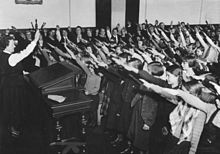
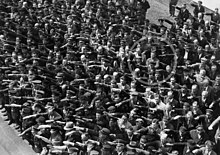
The salute became an ordinary way of life.[33] Postmen used the greeting when they knocked on people's doors to deliver packages or letters.[33] Small metal signs that reminded people to use the Hitler salute were displayed in public squares and on telephone poles and street lights throughout Germany.[34] Department store clerks greeted customers with “Heil Hitler, how may I help you?”[33] Dinner guests brought glasses etched with the words "Heil Hitler" as house gifts.[33] The salute was required of all persons passing the Feldherrnhalle in Munich, site of the climax of the 1923 Beer Hall Putsch, which the government had made into a shrine to the Nazi dead; so many pedestrians avoided this mandate by detouring through the small Viscardigasse behind that the passage acquired the nickname "Dodgers' Alley" (Drückebergergasse).[35]
Children were indoctrinated at an early age.[36] Kindergarten children were taught to raise their hand to the proper height by hanging their lunch bags across the raised arm of their teacher.[36] At the beginning of first grade primers was a lesson on how to use the greeting.[36] The greeting found its way into fairy tales, including classics like Sleeping Beauty.[36] Students and teachers would salute each other at the beginning and end of the school day, between classes, or whenever an adult entered the classroom.[37]
Some athletes used the Nazi salute in the opening ceremony of the 1936 Berlin Olympics as they passed by Hitler in the reviewing stand.[38] This was done by delegates from Afghanistan, Bermuda, Bulgaria, Bolivia, France, Greece, Iceland, Italy and Turkey.[38] The Bulgarian athletes performed the Nazi salute and broke into a goose-step;[38] Turkish athletes maintained the salute all around the track.[39] There is some confusion over the use of the salute, since the stiff-arm Nazi salute could have been mistaken for an Olympic salute, with the right arm held out at a slight angle to the right from the shoulder.[38] According to the American sports writer Jeremy Schaap, only half of the athletes from Austria performed a Nazi salute, while the other half gave an Olympic salute. According to the historian Richard Mandell, there are conflicting reports on whether athletes from France performed a Nazi salute or an Olympic Salute.[39] In football, the England football team bowed to pressure from the British foreign office and performed the salute during a friendly match on 14 May 1938.[40]
Military use

The Wehrmacht refused to adopt officially the Hitler salute and was able for a time to maintain its own customs.[41] A compromise edict from the Reich Defense Ministry, released on 19 September 1933, required the Hitler salute of soldiers and uniformed civil servants while singing the Horst Wessel Lied and national anthem, and in non-military encounters both within and outside the Wehrmacht (for example, when greeting members of the civilian government). At all other times they were permitted to use their traditional salutes.[41] Use of the Hitler salute was also permitted when in uniform. However, it is of importance to note that according to (pre-Nazi) Reichswehr and Wehrmacht protocol, the traditional military salute was not permitted when the saluting soldier was not wearing a uniform headgear (helmet or cap). Because of this, all salutes performed bareheaded, even when in full uniform and on duty made the Nazi salute de facto mandatory in most situations.[42]
Only after the 20 July Plot in 1944 were the military forces of the Third Reich ordered to replace the standard military salute with the Hitler salute, as a show of loyalty in deference to the fact that it was Army officers that had been responsible for the assassination attempt.[43] The order went into effect on 24 July 1944.[43] The use of the Hitler salute by the military had been discussed as early as January 1944 in a conference regarding traditions in the military at Hitler's headquarters. Field Marshal Wilhelm Keitel, head of the Armed Forces, had expressed a desire to standardize the salute across all organizations in Germany.[44]
On the night of 3 January 1942, Hitler stated the following about the compromise edict of 1933:[25]
I imposed the German salute for the following reason. I'd given orders, at the beginning, that in the Army I should not be greeted with the German salute. But many people forgot. Fritsch drew his conclusions, and punished all who forgot to give me the military salute, with fourteen days' confinement to barracks. I, in turn, drew my conclusions and introduced the German salute likewise into the Army.
— Adolf Hitler, Hitler's Table Talk
Satiric responses
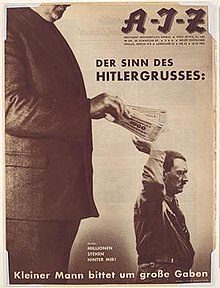
Despite indoctrination and punishment, the salute was ridiculed by some people. Since "heil" is also the imperative of the German verb "heilen" ("to heal"), a common joke in Nazi Germany was to reply with "Is he sick?", "Am I a doctor?", or "You heal him!"[45] Jokes were also made by distorting the phrase. So for example Heil Hitler might become Ein Liter ("One liter").[45] Cabaret performer Karl Valentin would quip, "It's lucky that Hitler's name wasn't 'Kräuter'. Otherwise, we'd have to go around yelling Heilkräuter ('medicinal herbs')".[45] Similar puns were made involving Bronn (rendering Heilbronn, a German city), and Butt (rendering Heilbutt, the German word for halibut).
Satirical use of the salute dates back to anti-Nazi propaganda in Germany before 1933. In 1932, photomontage artist John Heartfield used Hitler's modified version, with the hand bent over the shoulder, in a poster that linked Hitler to Big Business. A giant figure representing right-wing capitalists stands behind Hitler, placing money in his hand, suggesting 'backhand' donations. The caption is, "the meaning of the Hitler salute" and "Millions stand behind me".[46] Heartfield was forced to flee in 1933 after the Nazi seizure of power in Germany.
Another example is a cartoon by New Zealand political cartoonist David Low, mocking the night of the long knives. Run in the Evening Standard on July 3, 1934, it shows Hitler with a smoking gun grimacing at terrified SA men with their hands up. The caption reads: "They salute with both hands now".[47]
Sieg Heil

Sieg Heil was a ritualistic chant used at mass rallies, where enthusiastic crowds answered Heil to the call of Sieg ("victory").[48] For example, at the 1934 Nuremberg Rally, Rudolf Hess ends his climactic speech with, "The Party is Hitler. But Hitler is Germany, just as Germany is Hitler. Hitler! Sieg Heil!"[49] At his total war speech delivered in 1943, audiences shouted Sieg Heil as Joseph Goebbels solicited from them "a kind of plebiscitary 'Ja'" to total war.[50]
On 11 March 1945, less than two months before the capitulation of Nazi Germany, a memorial for the dead of the war was held in Marktschellenberg, a small town near Hitler's Berghof residence.[51] The British historian Ian Kershaw marks that the power of the Führer-cult and the 'Hitler Myth' had vanished which is evident from a report given in the little Bavarian town of Markt Schellenberg on March 11, 1945:
"When the leader of the Wehrmacht unit at the end of his speech called for a Sieg Heil for the Führer, it was returned neither by the Wehrmacht present, nor by the Volkssturm, nor by the spectators of the civilian population who had turned up. This silence of the masses... probably reflects better than anything else, the attitudes of the population."[51]
The Swing Kids (Template:Lang-de) were a group of middle-class teenagers who consciously separated themselves from Nazism and its culture, greeting each other with 'Swing-Heil!' and addressing one another as 'old-hot-boy'.[52] This playful behaviour was dangerous for participants in the subculture; on 2 January 1942, Heinrich Himmler ordered that the leaders be put in concentration camps to be drilled and beaten.[52]
Post-1945
Today in Germany, Nazi salutes in written form, vocally, and even straight-extending the right arm as a saluting gesture (with or without the phrase), are illegal.[53][54] It is a criminal offence punishable by up to three years of prison (Strafgesetzbuch section 86a).[54][55] Usage for art, teaching and science is allowed unless "the existence of an insult results from the form of the utterance or the circumstances under which it occurred".[55] Use of the salute has also been illegal in Austria since the end of World War II.
Usage that is "ironic and clearly critical of the Hitler Greeting" is exempt, which has led to legal debates as to what constitutes ironic use.[56] One recent case involved Prince Albrecht of Hanover, who was brought to court after using the gesture as a commentary on the behavior of an unduly zealous airport baggage inspector.[56] On 23 November 2007, the Amtsgericht Cottbus sentenced Horst Mahler to six months of imprisonment without parole for having, according to his own claims, ironically performed the Hitler salute when reporting to prison for a nine-month term a year earlier.[57] The following month, a pensioner named Roland T was given a prison term of five months for, amongst other things, training his dog Adolf to raise his right paw in a Nazi salute every time the command "Heil Hitler!" was uttered.[58]
Modified versions of the salute are sometimes used by neo-Nazis. One such version is the so-called "Kühnen salute" with extended thumb, index and middle finger, which is also a criminal offence in Germany.[59] In written correspondence, the number 88 is sometimes used by some neo-Nazis as a substitute for "Heil Hitler" ("H" as the eighth letter of the alphabet).[60] Swiss neo-nazis were reported to use a variant of the Kühnengruss, thought extending one's right arm over their head and extending said three fingers has a different historical source for Switzerland, as the first three Eidgenossen or confederates are often depicted with this motion.
On 28 May 2012, BBC current affairs programme Panorama examined the issues of racism, antisemitism and football hooliganism, which it claimed were prevalent among Polish and Ukrainian football supporters. The programme, titled Euro 2012: Stadiums of Hate, included recent footage of Ukrainian supporters giving the Nazi salute and shouting "Sieg Heil". The two countries hosted the international football competition UEFA Euro 2012.[61]
On 16 March 2013, Greek footballer Giorgos Katidis of AEK Athens F.C. was handed a life ban from the Greek national team for performing the salute after scoring a goal against Veria F.C. in Athens' Olympic Stadium.[62]
On 9 December 2013, two Turkish students were arrested after apparently raising their arms in a Hitler salute at the former Nazi German death camp of Auschwitz.[63]
In popular culture
- In a running gag in Hogan's Heroes, Colonel Klink often forgets to give the Hitler salute at the end of a phone call; instead, he usually asks, "What's that?" and then says, "Yes, of course, Heil Hitler".[64] In the German language version of the show, called Ein Kafig Voller Helden (A Cage Full of Heroes), "Col. Klink and Sgt. Schultz have rural Gomer Pyle-type accents", and "stiff-armed salutes are accompanied by such witticisms as "this is how high the cornflowers grow".[65]
- Numerous references are made to Germany, German culture, Hitler, and Nazis throughout the cable television series Breaking Bad, and several characters parody the Hitler salute. Examples include Jesse Pinkman's angry reply to Walter White's criticism that Jesse didn't follow his instructions: "Oh, well, Heil Hitler, bitch!", Jesse spits out, while parodying the Nazi salute (in the season 1 episode, "And the Bag's in the River"); Hank Schrader's explanation to his wife Marie that the DEA cannot force Walter to join them in protective custody because, "We're not Nazi Germany" (in the season 4 episode, "End Times"); and in that same episode DEA agent Steve Gomez's Nazi salute-like farewell gesture to Dennis, the manager of Gus Fring's laundry business, whom Gomez has convinced to allow a warrantless search of the premises for drugs; Dennis tentatively returns the gesture.[66]
- Several musicians have been accused of Nazi sympathies for gestures similar to this salute, namely David Bowie in 1973 and Deafheaven in 2014.[citation needed]
Notes
- ^ a b c d Kershaw (2001) p.60
- ^ Büchner, Alex (1991). German Infantry Handbook, 1939–1945: Organization, Uniforms, Weapons, Equipment, Operations. Schipper Publishing. ISBN 978-0-88740-284-5.
- ^ Czech Republic: A German put in jail for Nazi salute Global Voices, 15 August 2008
- ^ a b c Grunberger, Richard (1995). The 12-year Reich: a social history of Nazi Germany, 1933–1945 (illustrated ed.). Da Capo Press. ISBN 9780306806605.
- ^ a b c Kershaw (2001), p. 26.
- ^ a b Lepage, Jean-Denis G. G. (2008). Hitler Youth, 1922–1945: An Illustrated History (illustrated ed.). McFarland. p. 70. ISBN 9780786439355.
- ^ Tilman (2009), p. 15.
- ^ Klee, Kulturlexikon, S. 227.
- ^ Knickerbocker, H.R. (2008). Is Tomorrow Hitler's?: 200 Questions on the Battle of Mankind (reprint ed.). Kessinger Publishing. p. 5. ISBN 9781417992775.
- ^ a b Mommsen, Hans (2003). The Third Reich Between Vision and Reality: New Perspectives on German History 1918–1945. German Historical Perspectives. Vol. Volume 12. Berg Publishers. p. 28. ISBN 9781859736272.
{{cite book}}:|volume=has extra text (help) - ^ a b Winkler (2009) p. 2
- ^ Winkler (2009), p. 55.
- ^ Boime, Albert (1987). Art in an age of revolution, 1750–1800. Social history of modern art. Vol. Volume 1. University of Chicago Press. pp. 400–401. ISBN 9780226063348.
{{cite book}}:|volume=has extra text (help) Boime states: "The brothers stretch out their arms in a salute that has since become associated with tyranny. The 'Hail Caesar' of antiquity (although at the time of the Horatti a Caesar had yet to be born) was transformed into the 'Heil Hitler' of the modern period. The fraternal intimacy brought about by the Horatii's dedication to absolute principles of victory or death ... is closely related to the establishment of the fraternal order ... In the total commitment or blind obedience of a single, exclusive group lies the potentiality of the authoritarian state." - ^ Boime, Albert (1993). Art in an age of Bonapartism, 1800–1815. Social history of modern art. Vol. 2 (reprint, illustrated ed.). University of Chicago Press. p. 46.
- ^ Winkler (2009), p. 51.
- ^ Winkler (2009), p. 40.
- ^ Winkler (2009), pp. 70–101.
- ^ Winkler (2009), pp. 74–101.
- ^ a b Falasca-Zamponi, Simonetta (2000). Fascist spectacle: the aesthetics of power in Mussolini's Italy. Studies on the history of society and culture. Vol. 28 (illustrated ed.). University of California Press. pp. 110–113. ISBN 9780520226777.
- ^ Evans, Richard J. (2005). "The Rize of Nazism". The Coming of the Third Reich (reprint, illustrated ed.). Penguin Group. pp. 184–185. ISBN 9780143034698.
- ^ a b c d Tilman (2009), p. 55.
- ^ Tilman (2009), pp.55–56
- ^ a b Tilman (2009), p. 56.
- ^ Kershaw, Ian (2000). Hitler, 1889–1936: hubris (illustrated ed.). W. W. Norton & Company. pp. 294, 689. ISBN 9780393320350.
- ^ a b Hitler, Adolf (1 October 2000). Bormann, Martin (ed.). Hitler's Table Talk 1941–1944. trans. Cameron, Norman; Stevens, R.H. Preface and Introduction: The Mind of Adolf Hitler by H.R. Trevor-Roper (3rd ed.). London: Enigma Books. pp. 172–173. ISBN 1-929631-05-7.
- ^ Bishop, Ronald (2007). "A Case of First Impression". Taking on the Pledge of Allegiance: the news media and Michael Newdow's Constitutional challenge. SUNY Press. p. 27. ISBN 9780791471814.
- ^ Leepson, Marc (2006). Flag: An American Biography. Macmillan. p. 171. ISBN 0-312-32309-3.
- ^ Wireless to THE NEW YORK TIMES (27 September 1933). "Nazi Salute Banned in Prisons". The New York Times. p. 12. Retrieved 26 February 2010.
- ^ Tilman (2009), p. 51.
- ^ a b Tilman (2009), p. 61.
- ^ Shore, Zachary (2003). What Hitler knew: the battle for information in Nazi foreign policy (illustrated ed.). Oxford University Press US. p. 33. ISBN 9780195154597.
- ^ a b Tilman (2009), p. 60.
- ^ a b c d Tilman (2009), p. 33
- ^ Tilman (2009), p. 34.
- ^ "Feldherrnhalle (Field Marshal's Hall) - Odeonsplatz". 2007. Archived from the original on 6 December 2010.
- ^ a b c d Tilman (2009), p. 35.
- ^ Tilman (2009), p. 38.
- ^ a b c d Schaap, Jeremy (2007). Triumph: the untold story of Jesse Owens and Hitler's Olympics. Houghton Mifflin Harcourt. pp. 163–166. ISBN 9780618688227.
- ^ a b Mandell, Richard D. (1987). The Nazi Olympics. Sports and society (illustrated, reprint ed.). University of Illinois Press. p. 149. ISBN 9780252013256.
- ^ Football, fascism and England's Nazi salute, BBC Magazine, 22 September 2003
- ^ a b Tilman (2009) pp. 80–82.
- ^ Reibert redivivus, in: Der Spiegel 5/1960, pp. 35–36, (January 27, 1960), available online in the Spiegel Online archives (retrieved: March 25, 2013).
- ^ a b Tilman (2009), p. 82.
- ^ Heiber, Helmut (2004). Hitler and his Generals: Military Conferences 1942–1945 (Enigma Books ed.). Enigma Books. p. 398. ISBN 1-929631-28-6.
- ^ a b c Tilman (2009), p. 44.
- ^ Jay, Martin (2001). "From Modernism to Post-Modernism". In T. C. W. Blanning (ed.). The Oxford illustrated history of modern Europe. Oxford Illustrated Histories (illustrated, reissue ed.). Oxford University Press. p. 261. ISBN 9780192854261.
- ^ Reynoldson, Fiona (1996). "The Nazi Regime 1933-1945". In Rosemary Rees (ed.). Weimar and Nazi Germany. Oxford Illustrated Histories (illustrated, reissue ed.). Heinemann. p. 42. ISBN 9780435308605.
- ^ Tilman (2009), p. 32.
- ^ Kershaw (2001), p. 69.
- ^ Kershaw (2000), pp. 561–562.
- ^ a b Kershaw (2000), p. 766.
- ^ a b Willett, Ralph (May 1989). "Hot Swing and the Dissolute Life: Youth, Style and Popular Music in Europe 1939–49". Popular Music. 8 (2). Cambridge University Press: 161. JSTOR 853465.
- ^ "Rechtsextremismus – Straftaten". hagalil.com. Retrieved 24 February 2010.
- ^ a b Tilman (2009), pp. 94–95.
- ^ a b "Criminal Code (Strafgesetzbuch, StGB)". Federal Law Gazette I,. 13 November 1998. pp. 945, p. 3322. Retrieved 14 February 2010.
{{cite web}}: CS1 maint: extra punctuation (link) - ^ a b Tilman (2009), p. 95.
- ^ "Sechs Monate für Hitlergruß" (in German). Die Zeit/dpa. 23 November 2007.
- ^ Paterson, Tony (21 December 2007). "Dog's Nazi salute lands owner in jail for five months". The Independent. UK. Retrieved 1 March 2010.
- ^ "Kühnengruß oder sechs Bier bei FPÖ-Parteitag?" (in German). Kleine Zeitung. 27 May 2009. Retrieved 27 August 2009. Second paragraph: "The Kühnengruß is regarded as a variation of the Hitler salute. In it the right arm is extended with three fingers spread. In Austria, unlike Germany, the salute is not prohibited".
- ^ Tilman (2009), p. 94.
- ^ "Asian fans racially abused in Euro 2012 stadium". BBC. 29 May 2012. Retrieved 29 May 2012.
- ^ http://www.bbc.co.uk/news/world-europe-21822165
- ^ "Turkish students arrested at Auschwitz after Nazi salute".
- ^ http://www.imdb.com/title/tt0058812/quotes
- ^ Dawn Trimble Bunyak (1 August 2005). Our Last Mission: A World War II Prisoner in Germany. University of Oklahoma Press. p. xix.
- ^ "The Intriguing German Connections In Breaking Bad". Spy District. Retrieved 9 March 2014.
References
- Kershaw, Ian (2000). Hitler: 1936–45 : Nemesis (illustrated ed.). W. W. Norton & Company. ISBN 9780393049947.
- Kershaw, Ian (2001). The "Hitler myth": image and reality in the Third Reich (2, reissue ed.). Oxford University Press. ISBN 9780192802064.
- Allert, Tilman (April 2009). The Hitler Salute: On the Meaning of a Gesture (Picador ed.). Picador. ISBN 9780312428303.
{{cite book}}: Unknown parameter|coauthors=ignored (|author=suggested) (help) - Winkler, Martin M. (2009). The Roman Salute: Cinema, History, Ideology. Columbus: Ohio State University Press. ISBN 9780814208649.

